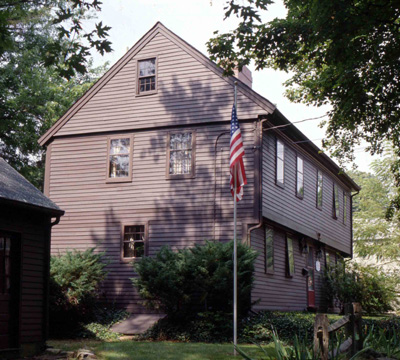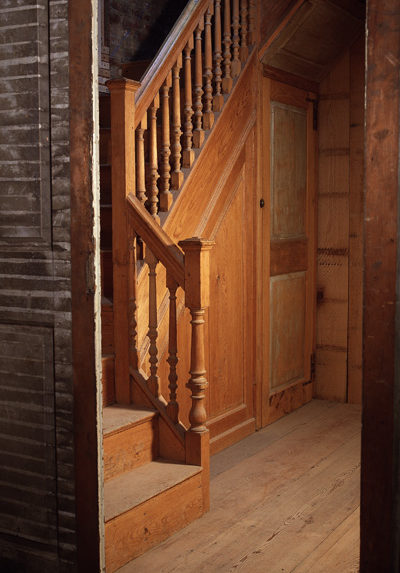Like the 250-year-old house from Ipswich in the Smithsonian’s National Museum of American History, your home has a story to tell and a place in history. Whether you own your house, rent it, or live in an apartment, you and your family can become house detectives and discover the history of your home.
1. Start at home. The best source about your home is the building itself, and everyone in the family can join in this part of the investigation. Look at the separate parts of the building—roof, walls, chimneys, doors, windows, and foundation. Note what materials they are made of and how the different parts are joined to one another. Try to distinguish original materials from later additions.
Look at the style of the house, too, inside and out (and use the books listed on the back panel of this brochure to help identify building styles and materials). The style of a building is a clue to its age—but not proof. In some parts of the country, a building style stays popular longer than in others. Keep careful notes and take pictures. The clues you record will be useful later on in your investigation.
2. Go to the courthouse, or wherever deed records are kept in your community. Using deed records, you can create a chronological list of all of the owners of a piece of property. The list you compile will be the backbone of your home’s history.
Ask for the index to deeds by buyer. Start with the deed to the present owner. Note the seller’s name and the legal description of the property. Then use the index to find the seller’s deed to the same piece of property and note whom the seller bought it from. Work your way back through the deeds to the original owner, make a copy of each deed, and keep track of the page and volume numbers. A sharp increase in the value of the property could mean a building was added to it.
3. Look at other public records, especially if you find gaps in the deed records. Sometimes property passes from one owner to another through a mortgage or a will, and these documents will probably be wherever you found the deeds (or at least nearby).
Mortgage records often contain detailed descriptions of buildings. Wills and other probate records may list one or more of the previous owners, and you can examine the records filed under their names to see if there are any mentions of the property. Local tax records may reveal the dates of additions and improvements to property by a change in its valuation, and maps of property made by surveyors can show a tool shed or a well that no longer exists. Be sure to make photocopies of all the records that you think will be helpful.

Photo courtesy of the National Museum of American History.
City directories often list people’s occupations as well as addresses and can help to establish the dates that a person lived at a particular address. A librarian can also direct you to federal and state census records. They can contain vast amounts of information about households.
A good library or Internet project for children is to create a timeline of American history starting with the approximate construction date of your building. When the kids have completed a simple timeline for the nation, the family can work together to combine it with the timeline for your home and look for connections. You might find a
link between a big event in American history and a small event in your home’s history.
5. Read a map. Your librarian can guide you to city and county maps that may show your building with the owner’s or resident’s name written beside it. Such maps often show the location of old roads and other landmarks that may have disappeared. Insurance maps, especially those produced by the Sanborn Map Co., contain a wealth of information about individual structures, including the materials from which they were built.
6. Look at a picture. Your local library or historical society may have old photographs of your building, or there may be some in your neighbors’ attics. Postcards can be helpful, too. Many towns are represented in nineteenth-century lithographs called “bird’s-eye views,” which sometimes provide an accurate picture of every residence in town. Don’t forget to take a few photographs of your home for the project, or better yet, have children in the family take the photographs or draw pictures of your building.
7. Talk to people. Try to track down former residents or their children. They may be able to help you date changes or tell you stories about their lives in your home. Neighbors can be helpful, too, if they have lived in the neighborhood a long time. The whole family can put together a list of questions to ask the neighbors about your home and neighborhood. While you are talking to them, ask if they have any family pictures that might show your building in the background.
8. Put it all together. When you have finished your research, you will have a stack of written notes, photocopies of documents and maps, and photographs. These are like the pieces of a puzzle. Use them to create a timeline of your home’s past and to write a narrative history. Enlist everyone in the family to help create a scrapbook that weaves together the narrative history, photocopies, drawings, and photographs, and then make enough copies to give your family and friends. Be sure to place a copy in your local historical society or library, so that your home will have a place in history.
9. Is the building you’re living in brand new? Then start your own history of your home. Using some of the steps outlined above, find out what was there before your building was built and why the neighborhood changed. Then take photos of your home and write about your experiences living in it. You will be making history for your family and community.
Further reading. These books to may help in your research:
Barbara J. Howe. Houses and Homes: Exploring Their History.
Nashville, Tennessee: American Association
for State and Local History, 1987.Howard Hugh. How Old Is This House?
New York: Noonday Press, 1989.Sally Light. House Histories: A Guide
to Tracing the Genealogy of Your Home.
Spencertown, New York: Golden Hill Press, 1997.Virginia and Lee McAlester. A Field Guide to American Houses.
New York: Alfred A. Knopf, 1997.
Visit the “Within These Walls…” website at
http://americanhistory.si.edu/house.
Become a Saturday Evening Post member and enjoy unlimited access. Subscribe now



